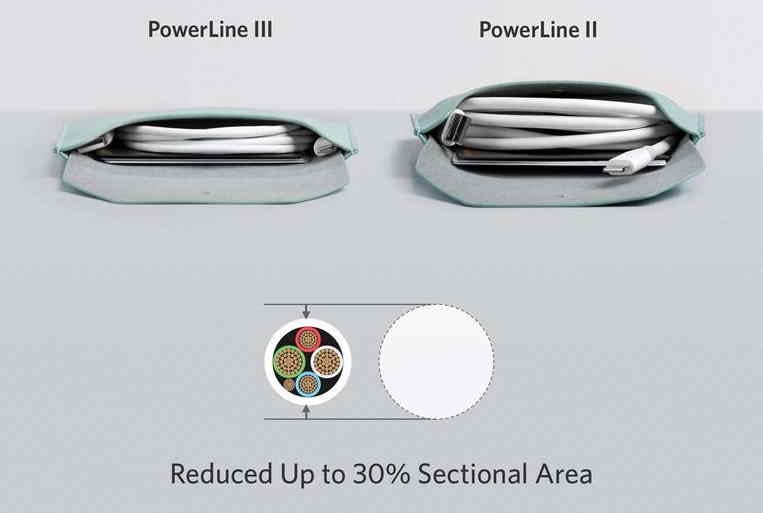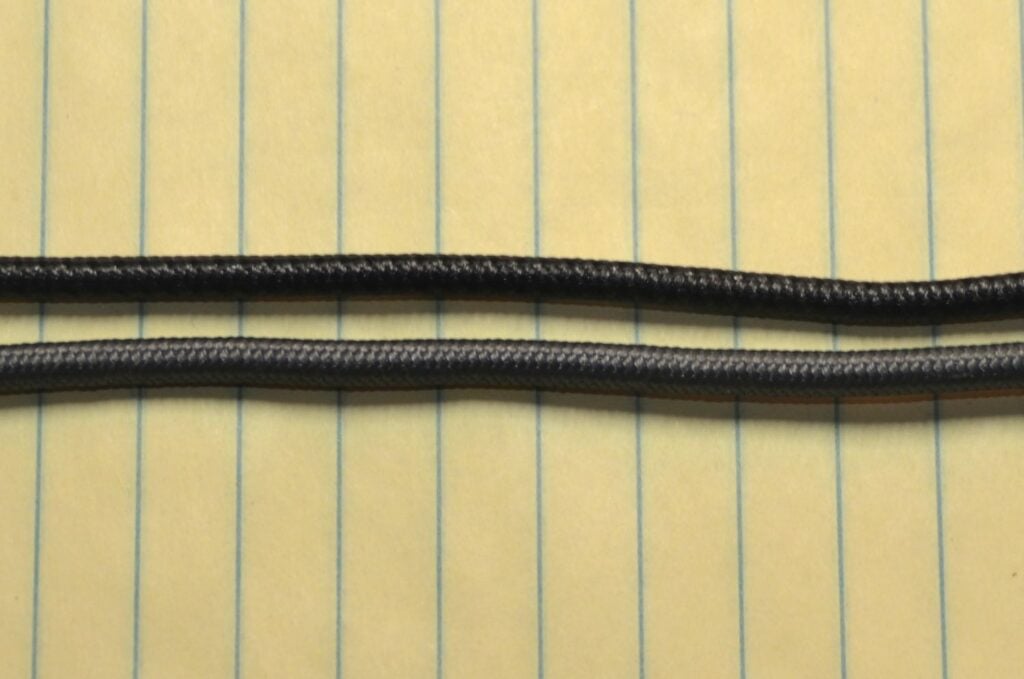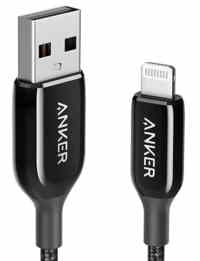A USB-to-Lightning cable is probably the most essential accessory for an iPhone. For many years, I used the white cords sold by Apple and included with the iPhone, but they seemed to wear out far too quickly, especially on one of the ends where this is a lot of wear-and-tear. After trying some of the different third-party cables, a few years ago I started using the cables made by Anker. I’ve been very happy with them, and over the years I have purchased quite a few of them for me, my wife, and my kids. Like the Apple cables, some of my Anker cables have worn out over time after a few years – especially the ones that get a lot of abuse by my kids — but they have worked better than the Apple cables and they are cheaper. And over the years, Anker has created even more durable versions of its cables. The latest generation is the Anker PowerLine+ III line, and I recently purchased one to replace a PowerLine+ I cable that is starting to occasionally lose its connection with my iPhone if I move the cable around. This is the cable that I’ve been using in my car for about three years to connect to a CarPlay system. That cable has an 18-month warranty, and since I leave it in my car, it gets exposed to a lot of high temperatures and gets a lot of use. For example, my kids sometimes use my iPhone in the back seat to select music to play while I am driving (which is one of the reasons that I use the 6-foot length), and that can result in a lot of tugging on the connectors at the end of the cable. In today’s post, I’ll talk about not just this specific cable but the entire Anker cable line because Anker’s own website doesn’t do a great job of explaining the differences between the different lines of cables.
In this post, I’m providing prices for the 6-foot version of each cable as a point of comparison. You can pay a little less for a 3-foot version and, for some models, a little more for a 10-foot version. Also, note that the prices change from time to time.
PowerLine versus PowerLine+
One series of cables from Anker is called PowerLine. Cables in this line have a PVC coating that feels sort of rubbery, similar to the standard white Apple cable. A 6-foot version of the first-generation PowerLine costs $14.99. Anker says that a typical cable sold by other companies will last for about 1,000 bends, whereas its first-generation PowerLine will last for 6,000 bends and comes with an 18-month warranty.
Another series of cables from Anker is called the PowerLine+. It features a double-braided nylon coating to make it more durable. The first-generation PowerLine+ also has an 18-month warranty, and Anker says that it will last over 6,000 bends. A 6-foot version of the first-generation PowerLine+ costs $16.99.
For many years, I’ve typically purchased a PowerLine+ for myself, but my kids sometimes preferred the bright colors that are available in the PowerLine series.
I versus II versus III
The original PowerLine and PowerLine+ don’t have “I” next to them, but I’ll use that roman numeral in this section just to distinguish between the I, the II that was reviewed on iPhone J.D. in 2018, and the III that I’m reviewing today.
Anker says that the PowerLine II is twice as durable as the PowerLine I — 12,000 bends versus 6,000 bends. And it currently costs the same, $14.99 for a 6-foot version. Instead of an 18-month warranty, Anker gives it a lifetime warranty for all quality issues.
Anker says that the PowerLine+ II is about five times as durable as the PowerLine+ I — 30,000 bends versus over 6,000 bends. As I described (and showed in pictures) in my 2018 post, the PowerLine+ II cord is just a hair thicker than the PowerLine+ I cord, and the plugs on the ends of the PowerLine+ II are a little bit larger and are more tapered than the PowerLine+ cord. It costs $20.99 for a 6-foot version.
Although I’ve had two or three first-generation Anker cords wear out over the years (after the 18-month warranty), I haven’t yet had a PowerLine+ II cord wear out. For example, my wife uses a PowerLine+ II cord that I bought about 19 months ago in the kitchen, and it still looks and works just like new. Thus, I have never had a reason to investigate making a warranty claim with Anker.
That brings us to the latest line, the III-series. Once again, you can get it either in the PowerLine or the PowerLine+ depending upon the coating for the cord that you prefer.
Anker says that the PowerLine III is about twice as durable as the PowerLine II — 25,000 bends versus 12,000 bends. It is also thinner than the PowerLine II, so it takes up less space in your briefcase, purse, etc. This image from Anker’s website shows this:

You can get a 6-foot version of the PowerLine III for $17.99 for the black version or $15.99 for the white version. I have not yet tried a PowerLine III cable, but if you prefer this style of coating for the cord, I would recommend getting the PowerLine III over the original PowerLine or the PowerLine II. Not only do you get something more durable for just a few dollars more, but it is always nice for a cable to take up less space.
That brings me to the current top-of-the-line Anker cable that I purchased, the PowerLine+ III. Anker says that the PowerLine+ III is slightly more durable than the PowerLine+ II — 35,000 bends versus 30,000 bends. It also comes with a lifetime warranty. You can get a 6-foot version of the PowerLine+ III for $25.99. I bought the black one, but you can also get it in silver.
In addition to having a more durable cord, there seem to be two other major changes for the PowerLine+ III.
First, the plastic on the USB and the Lightning ends utilizes what Anker calls a premium design and material. It certainly feels stronger and durable. And considering that the connectors on each end of a cord are the stress points, you want them to be as strong as possible. Every time I plug my iPhone into this cable, the connection seems incredibly secure, better than I’ve ever experienced with any other Lightning cable.
In this picture, you can see the USB connector end of three PowerLine+ cables. The top is the PowerLine+ III, the middle is the PowerLine+ II, and the bottom is the original PowerLine+ I.

The next picture shows the other end of the cable with the Lightning connector. The top is the PowerLine+ III, the middle is the PowerLine+ II, and the bottom is the original PowerLine+ I.

A second difference is that the PowerLine+ III cord is a little bit thinner than previous generations. Anker says: “PowerLine+ III has an ultra-slim design with a 35,000-bend lifespan for a cable that is slimmer, yet stronger than ever before.” The difference in cord circumference is minor in the PowerLine+ series (not as dramatic as the new PowerLine III series). In the following picture, the new PowerLine+ III is at the top and the original PowerLine+ I is at the bottom. You can only barely see the difference in the below picture, but trust me, when each cord is wrapped up, I can definitely feel the difference between the two. And I find the slimmer cord easier to work with, so this is a nice new feature.

No case
When I purchased previous generations of the PowerLine and PowerLine+ cables, they came with cases, pictured in my 2018 post. The 6-foot PowerLine+ III that I purchased did not come with a case, just a small Velcro strap that you can attach to one of the ends of the cable. Over the years, I’ve only rarely used the cases so I don’t really miss it. And a Velcro strap that you can (optionally) keep attached to the cord seems more useful. I guess that omitting a case is one of the ways that Anker is keeping the price lower on the new model.
Conclusion
Although Anker has come out with three different generations of PowerLine cables, the company continues to sell all three, in two different lines, and I think that this makes sense. For a kid that is going to abuse the cable, you might want to get one of the cheapest models and know that it will need to be replaced in the future. If you prefer the feel and additional durability of the double-braided nylon coating, then the PowerLine+ series is the way to go.
The top-of-the-line PowerLine+ III is the most expensive model, but the difference between $15 for the cheapest model and $26 for this newest 6-foot cable isn’t really that big of a difference. Since I plan to use this cable in my car — which as I noted above, puts a lot of stress on the cable — I figured that it was worth it to spend just a few more dollars for the best cable that Anker sells. Whichever model you decide is right for you, I can definitely recommend Anker’s line of cables.
Click here for the PowerLine+ III from Amazon ($25.99)
Click here for the PowerLine+ II from Amazon ($20.99)
Click here for the first-generation PowerLine+ from Amazon ($16.00)
Click here for the PowerLine III from Amazon ($17.99)
Click here for the PowerLine II from Amazon ($14.99)
Click here for the first-generation PowerLine from Amazon ($14.99)


Nice writeup. Agree Anker are good value long lasting and reliable. Apple cords work great but wear out faster. Amazon cords were great but latest are fat and inflexible. Other cables may not work with newer phones or connectors too fat for your case not worth the hassle. Thanks for comparison I did not understand the difference between Anker II and III.
Thank you. For years I’ve tried to figure out the various Anker cables models. I’ve ordered many over the years but was largely flying blind. This was the clearest distinction I’ve read. Appreciate your article very much.
Great article. Thanks